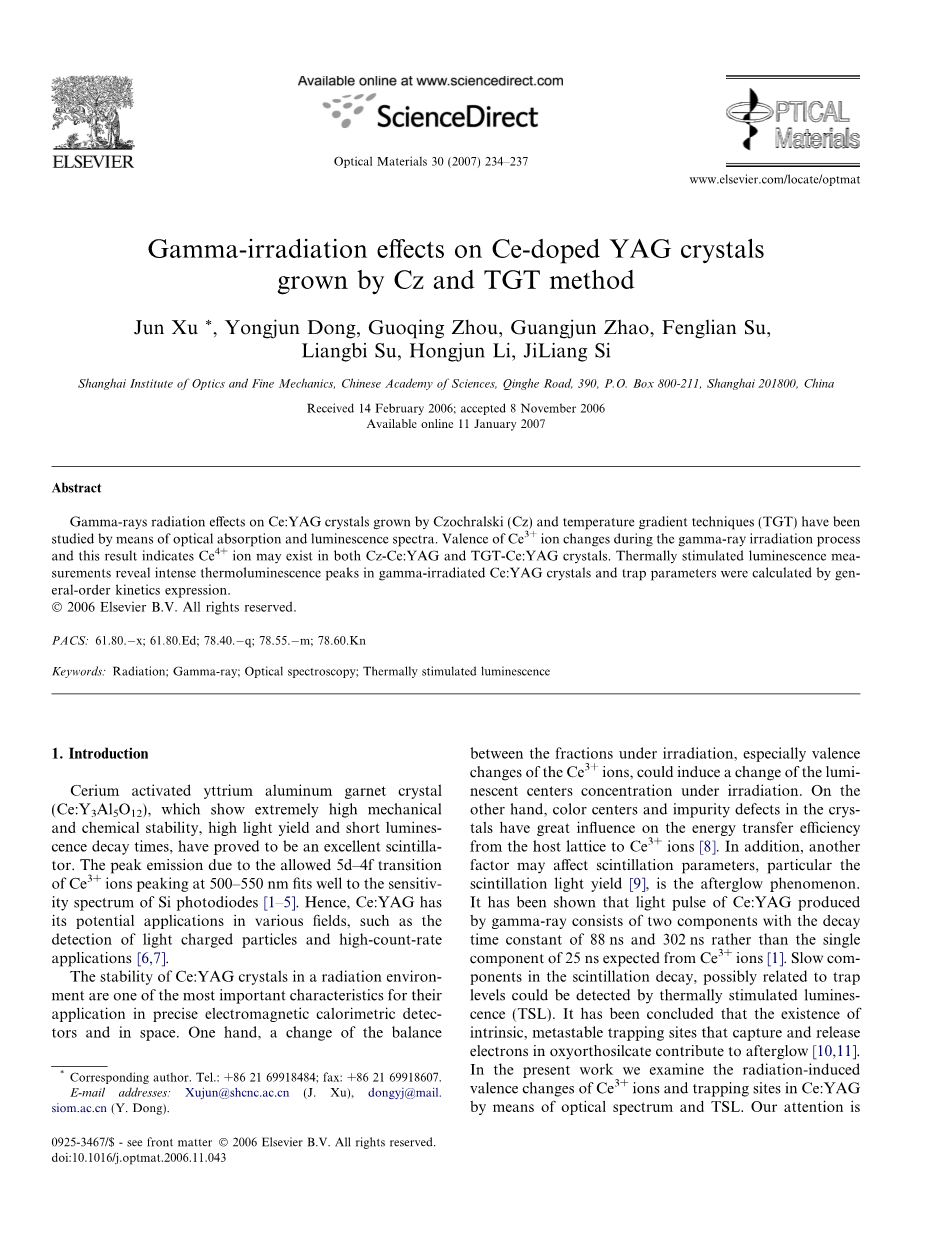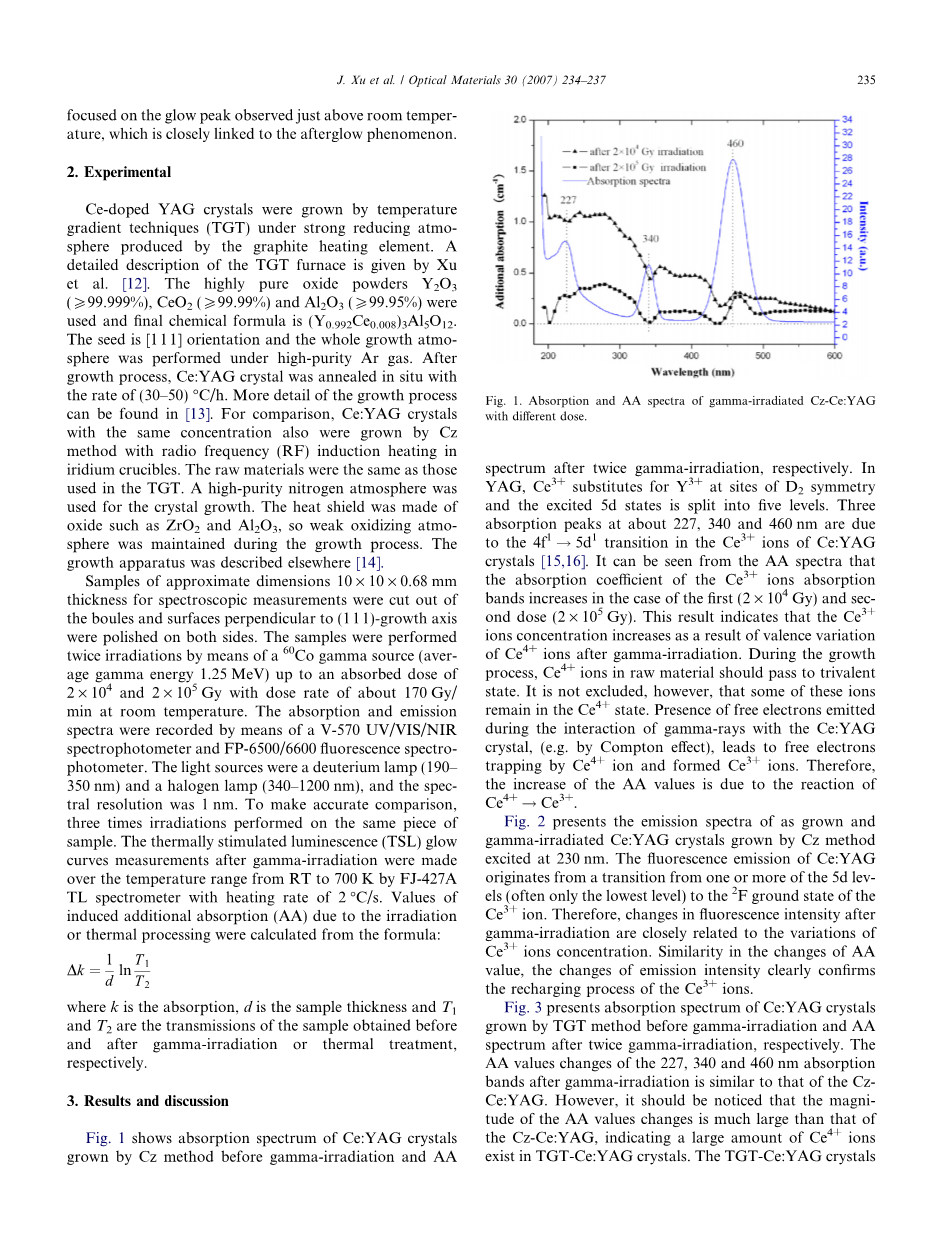

英语原文共 4 页,剩余内容已隐藏,支付完成后下载完整资料
Gamma-irradiation effects on Ce-doped YAG crystals grown by Cz and TGT method
Jun Xu *, Yongjun Dong, Guoqing Zhou, Guangjun Zhao, Fenglian Su,
Liangbi Su, Hongjun Li, JiLiang Si
Shanghai Institute of Optics and Fine Mechanics, Chinese Academy of Sciences, Qinghe Road, 390, P.O. Box 800-211, Shanghai 201800, China
Abstract
Gamma-rays radiation effects on Ce:YAG crystals grown by Czochralski (Cz) and temperature gradient techniques (TGT) have been studied by means of optical absorption and luminescence spectra. Valence of Ce3 ion changes during the gamma-ray irradiation process and this result indicates Ce4 ion may exist in both Cz-Ce:YAG and TGT-Ce:YAG crystals. Thermally stimulated luminescence measurements reveal intense thermoluminescence peaks in gamma-irradiated Ce:YAG crystals and trap parameters were calculated by general-order kinetics expression.
Keywords: Radiation; Gamma-ray; Optical spectroscopy; Thermally stimulated luminescence
1. Introduction
Cerium activated yttrium aluminum garnet crystal (Ce:Y3Al5O12), which show extremely high mechanical and chemical stability, high light yield and short luminescence decay times, have proved to be an excellent scintillator. The peak emission due to the allowed 5d–4f transition of Ce3 ions peaking at 500–550 nm fits well to the sensitivity spectrum of Si photodiodes. Hence, Ce:YAG has its potential applications in various fields, such as the detection of light charged particles and high-count-rate applications.
The stability of Ce:YAG crystals in a radiation environment are one of the most important characteristics for their application in precise electromagnetic calorimetric detectors and in space. One hand, a change of the balance between the fractions under irradiation, especially valence changes of the Ce3 ions, could induce a change of the luminescent centers concentration under irradiation. On the other hand, color centers and impurity defects in the crystals have great influence on the energy transfer efficiency from the host lattice to Ce3 ions. In addition, another factor may affect scintillation parameters, particular the scintillation light yield, is the afterglow phenomenon. It has been shown that light pulse of Ce:YAG produced by gamma-ray consists of two components with the decay time constant of 88 ns and 302 ns rather than the single component of 25 ns expected from Ce3 ions. Slow components in the scintillation decay, possibly related to trap levels could be detected by thermally stimulated luminescence (TSL). It has been concluded that the existence of intrinsic, metastable trapping sites that capture and release electrons in oxyorthosilcate contribute to afterglow. In the present work we examine the radiation-induced valence changes of Ce3 ions and trapping sites in Ce:YAG by means of optical spectrum and TSL. Our attention is focused on the glow peak observed just above room temperature, which is closely linked to the afterglow phenomenon.
2. Experimental
Ce-doped YAG crystals were grown by temperature gradient techniques (TGT) under strong reducing atmosphere produced by the graphite heating element. A detailed description of the TGT furnace is given by Xu et al. The highly pure oxide powders Y2O3 (ge;99.999%), CeO2 (ge;99.99%) and Al2O3 (ge;99.95%) were used and final chemical formula is (Y0.992Ce0.008)3Al5O12. The seed is [111] orientation and the whole growth atmosphere was performed under high-purity Ar gas. After growth process, Ce:YAG crystal was annealed in situ with the rate of (30–50) C/h. More detail of the growth process can be found in “Characteristics of large-sized Ce:YAG scintillation crystal grown by temperature gradient technique”. For comparison, Ce:YAG crystals with the same concentration also were grown by Cz method with radio frequency (RF) induction heating in iridium crucibles. The raw materials were the same as those used in the TGT. A high-purity nitrogen atmosphere was used for the crystal growth. The heat shield was made of oxide such as ZrO2 and Al2O3, so weak oxidizing atmosphere was maintained during the growth process. The growth apparatus was described elsewhere.
Samples of approximate dimensions 10 times; 10 times; 0.68 mm thickness for spectroscopic measurements were cut out of the boules and surfaces perpendicular to (111)-growth axis were polished on both sides. The samples were performed twice irradiations by means of a 60Co gamma source (average gamma energy 1.25 MeV) up to an absorbed dose of 2times;104 and 2times;105 Gy with dose rate of about 170 Gy/ min at room temperature. The absorption and emission spectra were recorded by means of a V-570 UV/VIS/NIR spectrophotometer and FP-6500/6600 fluorescence spectrophotometer. The light sources were a deuterium lamp (190–350 nm) and a halogen lamp (340–1200 nm), and the spectral resolution was 1 nm. To make accurate comparison, three times irradiations performed on the same piece of sample. The thermally stimulated luminescence (TSL) glow curves measurements after gamma-irradiation were made over the temperature range from RT to 700 K by FJ-427A TL spectrometer with heating rate of 2 C/s. Values of induced additional absorption (AA) due to the irradiation or thermal processing were calculated from the formula:
where k is the absorption, d is the sample thickness and T1 and T2 are the transmissions of the sample obtained before and after gamma-irradiation or thermal treatment, respectively.
3. Results and discussion
Fig. 1 shows
剩余内容已隐藏,支付完成后下载完整资料
资料编号:[587281],资料为PDF文档或Word文档,PDF文档可免费转换为Word
以上是毕业论文外文翻译,课题毕业论文、任务书、文献综述、开题报告、程序设计、图纸设计等资料可联系客服协助查找。


